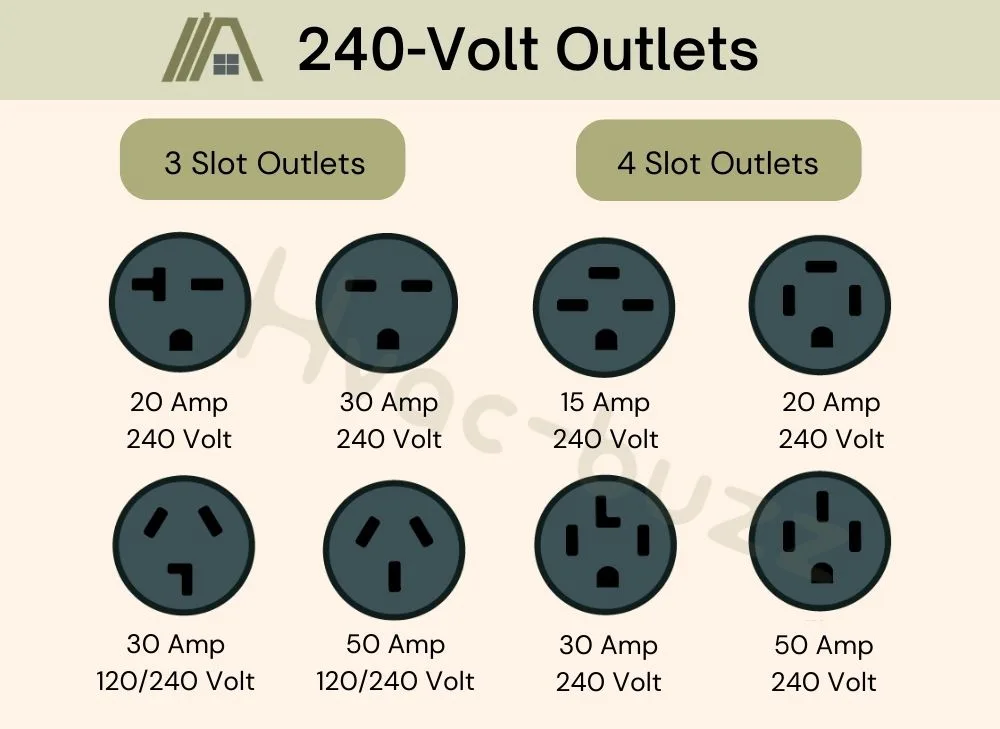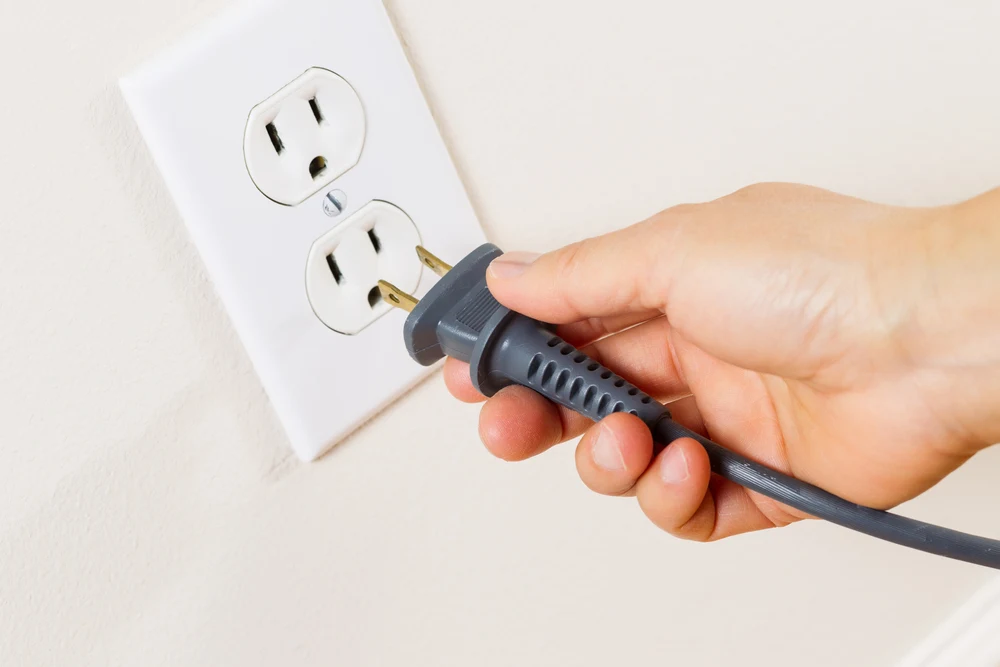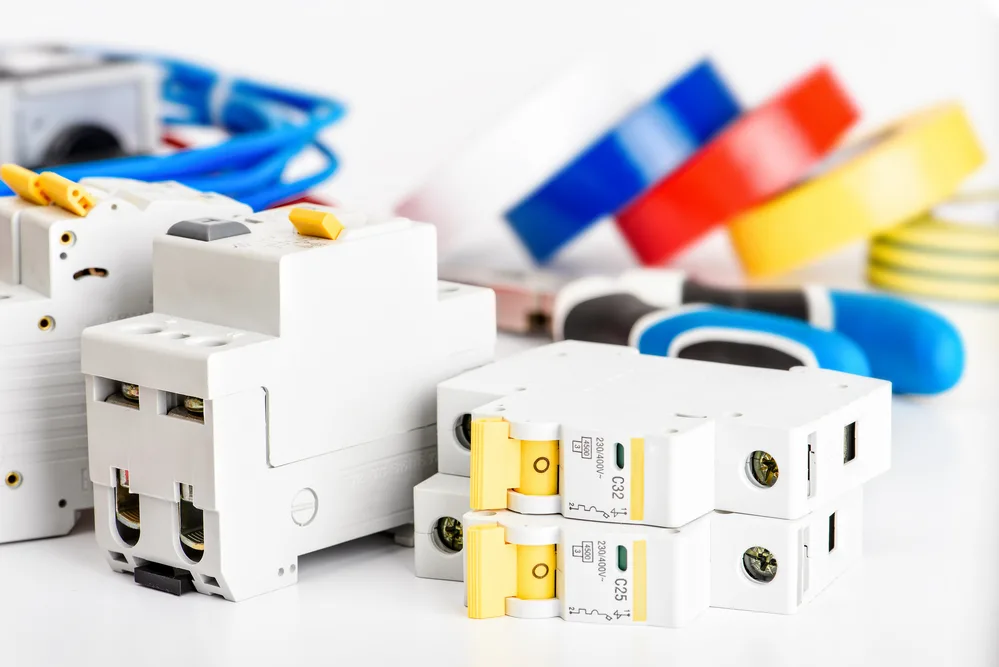Dryers, along with other larger appliances, require large amounts of electricity. In most cases, this means a specific type of outlet is needed and may have to be installed if it’s not readily available. While most modern homes come with these standards built-in, older ones may need to be updated.
When it comes to electricity, safety is a major concern. It’s important for homeowners to know what is safe and what is not concerning electrical outlets, extension cables, and other mandated electrical standards for dryers.

A 240-volt, GFCI-protected electrical outlet is the new standard for electric dryers. Additionally, four receptacle slots are recommended for the safest dryer use. Regular outlets are 120-volt, so they aren’t appropriate. Gas dryers use electricity, but much less of it. They are usually rated 120-volts.
240-Volt Outlets Required for Electric Dryers
All dryers are powered by electricity, even gas dryers. However, gas dryers require less electricity than fully electric ones (we talk about this a little later).
Electric dryers require at least 240-volt outlets because of how much electricity they require to run.
The importance of using at least a 240-volt electrical outlet goes beyond just properly powering your dryer, though. There are serious safety risks that come into play when guidelines concerning electricity are not followed.

The National Fire Protection Association estimates that in a year, 47,700 residential fires are caused due to electrical failure and malfunction. Electrical fires can be started in a variety of ways but overloaded electrical circuits are one of the most common reasons.
Electricity has become such a familiar resource in modern society that it’s easy to forget how dangerous it can be. Do yourself a favor and connect your dryer to a suitable electrical outlet and learn more about how to prevent circuit overloads.
Gas Dryers Use Less Electricity
Gas dryers, which only require electricity for some operational functions, only pull about 120 volts. The additional power required to provide the actual heating function of the dryer is supplied by burning gas.
Thus, for gas dryers, you should be able to use a 120-volt outlet.
However, I would recommend checking that your appliance has this voltage rating or lower. Some gas dryers may have a higher rating, so don’t just assume.
Can a Dryer Be Plugged Into a Regular Outlet

Gas and compact electric dryers can be used with regular 120V outlets. However, standard electric dryers require specialized, dedicated outlets with 240V supply voltage. An electric dryer connected to a regular outlet is unsafe. It won’t work properly, will damage the appliance, and is a hazard.
Voltage Rating of Regular Outlets
The standard outlet voltage in the U.S. is 120 volts.

Now, you may have heard people referring to 110V outlets. This came about because of certain transmission losses from the outlet to the receptacle (yes, there is a difference between the terms), which means that 120V might end up as 110V.
110V was the original voltage requirement, according to Thomas Eddison, and 120V allowed for losses without compromising functionality.
There are also several 240V outlets installed in houses to supply larger appliances that need more electricity (sometimes appliances can be small and still pull lots of power, like hair dryers).
The reason for standardizing outlets was to cater to the initial lightbulbs and all the following household appliances. Can you imagine the chaos if no manufacturer knew what supply voltages could be found in any single home? You might end up buying a hairdryer or microwave that cannot work in your plugs.
Most appliances are designed for 120V. If slightly too little electricity was supplied to the appliance, it might just not function as optimally. You are unlikely to even notice this, though. Comparatively, overloading an appliance can be highly dangerous.
Voltage Ratings for Dryers
Different types of dryers require different voltage ratings. This rating can be found in the product information, but the dryer will either need 120V or 240V.
Electric dryers are listed under a voltage rating of 240V (or 220V). These, like the KENMORE 29” Front Load Electric Dryer (amazon link), use a lot of electricity to move the barrel, heat the air, operate the controls, and power the fan to distribute the heat.
The electrical rating for gas dryers is 120V. Gas dryers use either liquid propane or natural gas to power the biggest power demand in the dryer: the element used to heat the dryer air.
However, gas dryers still need some electricity. This electricity is used to power the other functions of the dryer, which have lower supply demand.
There are also smaller, compact versions of electrical dryers, rated at 110V or 120V. For example, the Panda Compact Portable Laundry Dryer (amazon link). These use less power due to their size. However, they are intended for much smaller operations with smaller loads, which means they are limited in capacity as well as power.
Why Standard Electric Dryers Use so Much Power
Think about the main contributors to your utility bills; your air conditioning and heating have probably popped into your head. This is because it takes a lot of energy to modify the temperature of air and maintain it.
The same goes for a dryer, the difference being that it works with a smaller space for much shorter periods.
Your dryer likely runs for an hour per load. This means that for an hour (or more if you are doing more than one load), electricity is needed to power the element and heat the air for the duration of the cycle.
That is the biggest draw on power, but there are also other continuous electrical demands for the fan to distribute the heat, the barrel to spin to aerate the clothing, and for the controls (including all the program settings and timer).
Dryers pull so much power that it is ill-advised to use extension leads with them. If extension leads must be used, they have to be heavy-duty and preferably only a temporary solution. This often means that installing washers and dryer sets in the master closet and other such places becomes more trouble than it is worth.
Gas and Compact Dryers Can Use Regular Outlets
A gas dryer can be plugged into a standard 120V (or 110V) outlet.
This is because the only electricity needed is to spin the barrel and power the control panel and fan, while the element for heating air is powered by gas. So, the total power needed is relatively small compared to regular electric dryers.
Compact electric dryers can use regular 120V outlets too.
Compact dryers are the mini, portable versions of the standard electric dryers. They are designed to take smaller clothing loads and are significantly smaller than their standard cousins.
This down-scaled operation means that these dryers require less electricity (110/120V) to operate and so can be used in a 120V outlet.
There are also portable dryers like the Nekithia Travel Mini 900W Dryer (amazon link). These are aimed at travel and small space living and are used with 110/120V outlets.
Electric Dryers Require Specialized Outlets
Due to the high voltage supply requirements, standard electric dryers have to be plugged into a 240V outlet. They might be rated as 220V for the transmission loss, but the specialized outlet is still used.
Also, these appliances are generally used on a single-use circuit. Being on its own circuit with a dedicated circuit breaker helps ensure that the dryer will get sufficient power for functioning and will help protect your house’s wiring and you if a fault occurs in the appliance wiring.
Depending on when the outlet was installed, this specialized outlet might be clearly marked by having 4 slots. However, there are 3-slot outlets that supply 240 V in older homes.
How Many Slots Should a Dryer Receptacle Have?
Before 1996, most dryers came with a three-prong power cable that connected to the 240-volt electrical outlet. However, after 1996 the NEC changed the standard and required that new installations include four-slot dryer outlets. Thus, new dryers come equipped with four-prong cords to match the outlets.
The number of slots increasing from three to four has no effect on the amount of electricity transferred from the electrical outlet and the dryer. The reasoning behind moving toward a four-prong cord and receptacle lies in further mitigating safety risks.
Since dryers are typically located in an area near water, there is a possibility of shock. The fourth prong and receptacle serve as an additional grounding pathway to decrease the chance of this.
Furthermore, if your dryer cord will only plug into a special 4 prong socket, then you are less likely to “try” it out in a regular 120-volt outlet.
Don’t worry if your house only has a three-prong receptacle; this can be replaced if necessary. The same goes for the opposite; if your house has a four-prong receptacle but your dryer has a three-prong cord. The power cable of your dryer can also be replaced.
Also, keep in mind that many new dryers come with no power cable at all since there are still so many types of each outlet in the U.S. However, if you’re installing a new 240-volt dryer outlet, it will always be a four-prong outlet in order to meet the codes of the NEC.
Laundry Outlets Must Have Own Branch Circuit
According to Section E3901.5 of IRC, at least one 20-ampere rated branch circuit is needed to power receptacle outlets located exclusively to the laundry area. More simply put, your dryer needs a dedicated 240-volt circuit.

Depending on the make and model of your dryer, the size of the breaker required will vary but will be disclosed on the dryer label.
As previously stated, larger appliances like electric dryers require more electricity than standard appliances. A dedicated circuit ensures that your dryer is the only appliance drawing energy from that circuit and prevents situations involving an overloaded circuit.
Outlets Must be Close to a Dryer
In accordance with Section E3901.5 of IRC, outlets specifically installed for the purpose of appliances regarding laundry equipment must be installed within 6 ft of the appliance.
Not only does this make it easier to provide a dedicated circuit to your dryer, but it also eliminates the need for an extension cord. Typically, power cords of dryers have a standard length of 6 ft or less making the outlet easily accessible according to the mandate in question.
Additionally, without the use of an extension cord, the standard power cable will be able to supply an adequate flow of electricity of at least 240 volts.
Can You Use an Extension Cable With a Dryer?
Extension cables can be used for dryers as long as it is a temporary fix and not something that should be relied on permanently. Ideally, you want the dryer close to the outlet that will supply the necessary electricity without the use of an extension cable.
If an extension cable is required for temporary use, further consultation may be required because not just any cable can be used to power a large appliance like a dryer.
When looking for an appropriate cable, keep in mind that, at the very least, a wattage rating of 1,800 is needed to power a dryer with the least electricity requirements.
The length of the extension cord also plays a role in the electricity that can be supplied; as the length of the cord increases, the amount of wattage that flows through decreases.
Dryer Receptacles Must Have GFCI Protection
Section E3902.9 of IRC states that receptacles ranging from 125 volts to 250 volts installed in laundry areas and supplied by single-phase branch circuits with ratings of 125 volts must have ground-fault circuit-interrupter (GFCI) protection for the appliances in question.

Situations in which an appliance is damaged or wet can cause electricity to flow outside of the circuit conductors on an unintentional path. Essentially, the purpose of a GFCI is to quickly interrupt the current to prevent an electrical accident.
The GFCI device senses imbalances in the amount of electricity flowing into and out of the circuit and decreases the risk of a dangerous shock. Also, because the GFCI trips the circuit quickly, it protects against overheating, fires, and therefore, the insulation of the wires.
There are three types of GFCIs: receptacle, circuit breaker, and portable. Receptacle-type GFCIs are the most common and for the most part, cost-effective. When looking to install a GFCI be sure to consult a professional electrician to ensure that the device works in the way it was intended.
Sources
https://www.esfi.org/understanding-your-home-electrical-system/
https://www.esfi.org/dont-overload-your-home/
https://www.rowse.co.uk/blog/post/what-causes-circuit-breakers-to-trip
https://www.thespruce.com/3-and-4-wire-dryer-receptacles-1152226
https://homeguides.sfgate.com/type-circuit-washer-dryer-91181.html
https://safeelectricity.org/ground-fault-circuit-interrupters-gfcis/
https://www.esfi.org/ground-fault-circuit-interrupters-gfci/

